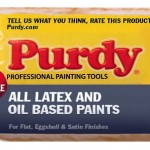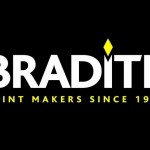The Right Brush for Every Job
 The quality and type of brush can make a huge difference to a decorator’s productivity. Here Andrew Cummins, Senior Product Manager at Purdy looks at what to consider.
The quality and type of brush can make a huge difference to a decorator’s productivity. Here Andrew Cummins, Senior Product Manager at Purdy looks at what to consider.
One of the greatest mistakes a professional decorator can make is the lack of investment in their tools. A lot of time, money and effort goes into a project, so while saving money by purchasing a cheap brush may seem desirable, it can significantly compromise the final finish.
Subpar brushes present a range of problems which include; visible brush marks from stiff bristles, brushes unable to retain paint therefore providing minimal coverage, and bristles becoming loose & trapped in paint. Cheap brushes are often not designed or shaped for a specific job, and unsuitable for wood finishes, trims, or cutting in, this ultimately means more time spent onsite, repainting and cleaning to correct these issues.
In contrast, a quality brush is going to have bristles that will be durable, able to provide a smoother finish and have increased paint pick up – meaning decorators will spend less time repeatedly having to “top up” the brush with more paint.
For example, these manufacturers will be able to supply brushes that have bolstered epoxy, meaning filaments are locked in, and will have a zero-loss guarantee – creating a longer lasting brush that also won’t ruin your paint job. Additionally, recent innovations allow for self-flagging filaments, which will eliminate any issues with brush marks.
 It goes beyond the handle and angle of the brush too – painters and decorators should be purchasing brushes that have specific filament blends for different types of paints and coatings. Purdy’s latest Cub Brush, for example, can be used with both oil and water-based paints and stains, with a unique blend of Dupont solid, round and tapered filaments ensuring a high quality finish every time. Designed specifically for use in tight spaces, the short, lightweight handle provides maximum control, and the angular style tip is perfect for cutting in and getting into tight corners.
It goes beyond the handle and angle of the brush too – painters and decorators should be purchasing brushes that have specific filament blends for different types of paints and coatings. Purdy’s latest Cub Brush, for example, can be used with both oil and water-based paints and stains, with a unique blend of Dupont solid, round and tapered filaments ensuring a high quality finish every time. Designed specifically for use in tight spaces, the short, lightweight handle provides maximum control, and the angular style tip is perfect for cutting in and getting into tight corners.
In addition, brushes designed to mimic natural ox-hair, like Purdy’s Syntox brush, will allow for a smooth, mirror-like finish on wood – and the angled version can be used to get the perfect finish quickly in hard-to-reach places.
It should come as no surprise that cheaper brushes often have shorter lifespans. As the adage goes, “buy cheap, buy twice” – and for painters and decorators, there is not just the monetary cost of repeatedly replacing tools, but the cost of your time, and the cost to fix a subpar job caused by inadequate tools.
Although cheap brushes may initially seem to be a cost-effective option, they can actually be a false economy. Investing in high-quality brushes will allow you to work more effectively and ensure a perfect finish. When purchasing new painting tools, save yourself from extra work and expense further down the line by insisting on the best.
The Right Brush for Every Job







